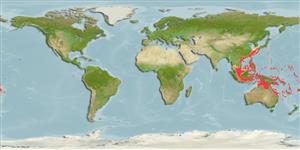Environment: milieu / climate zone / depth range / distribution range
Sinh thái học
Biển Cùng sống ở rạn san hô; Mức độ sâu 2 - 150 m (Ref. 9710). Tropical; 34°N - 36°S, 99°E - 174°W (Ref. 5222)
Western Pacific: southern Japan to southern Queensland and east to Fiji and the islands of Micronesia. Recently recorded from Tonga (Ref. 53797). Record from Western Australia in the Indian Ocean is dubious. Replaced by Epinephelus flavocaeruleus in the Indian Ocean (Ref. 37816).
Length at first maturity / Bộ gần gũi / Khối lượng (Trọng lượng) / Age
Maturity: Lm ?, range 64 - ? cm
Max length : 122 cm TL con đực/không giới tính; (Ref. 4787); Khối lượng cực đại được công bố: 17.3 kg (Ref. 40637)
Các tia vây lưng cứng (tổng cộng) : 11; Các vây lưng mềm (tổng cộng) : 16 - 17; Tia cứng vây hậu môn: 3; Tia mềm vây hậu môn: 8. Juveniles are mostly yellow becoming gray with dark spots anteriorly. The gray area increases with increasing size until only the fins remain yellow on individuals of 15 to 20 cm (Ref. 37816).
Usually found around isolated coral heads in lagoons or bays, but also caught on outer reef area. According to Myers (1989, Ref. 4538) it usually swims out in the open, several meters above the bottom. It is readily caught by anglers at night. Feeds mainly on sand-dwelling fishes and crustaceans such as snake eels and box crabs. In Hong Kong live fish markets (Ref. 27253).
Life cycle and mating behavior
Chín muồi sinh dục | Sự tái sinh sản | Đẻ trứng | Các trứng | Sự sinh sản | Ấu trùng
Heemstra, P.C. and J.E. Randall, 1993. FAO Species Catalogue. Vol. 16. Groupers of the world (family Serranidae, subfamily Epinephelinae). An annotated and illustrated catalogue of the grouper, rockcod, hind, coral grouper and lyretail species known to date. Rome: FAO. FAO Fish. Synop. 125(16):382 p. (Ref. 5222)
IUCN Red List Status (Ref. 130435: Version 2024-1)
Threat to humans
Reports of ciguatera poisoning (Ref. 1602)
Human uses
Các nghề cá: buôn bán nhỏ; Bể nuôi cá: Bể cá công cộng
Các công cụ
Special reports
Download XML
Các nguồn internet
Estimates based on models
Preferred temperature (Ref.
123201): 22.5 - 29, mean 27.8 °C (based on 1250 cells).
Phylogenetic diversity index (Ref.
82804): PD
50 = 0.5000 [Uniqueness, from 0.5 = low to 2.0 = high].
Bayesian length-weight: a=0.01122 (0.00702 - 0.01794), b=3.05 (2.92 - 3.18), in cm total length, based on LWR estimates for this species & Genus-body shape (Ref.
93245).
Mức dinh dưỡng (Ref.
69278): 4.1 ±0.5 se; based on diet studies.
Thích nghi nhanh (Ref.
120179): Rất thấp, thời gian nhân đôi của chủng quần tối thiểu là hơn 14 năm (Preliminary K or Fecundity.).
Fishing Vulnerability (Ref.
59153): High to very high vulnerability (73 of 100).
Nutrients (Ref.
124155): Calcium = 15.1 [7.2, 34.0] mg/100g; Iron = 0.448 [0.226, 0.897] mg/100g; Protein = 18.4 [16.8, 19.9] %; Omega3 = 0.112 [0.067, 0.188] g/100g; Selenium = 51 [27, 103] μg/100g; VitaminA = 192 [50, 735] μg/100g; Zinc = 0.956 [0.646, 1.371] mg/100g (wet weight);
